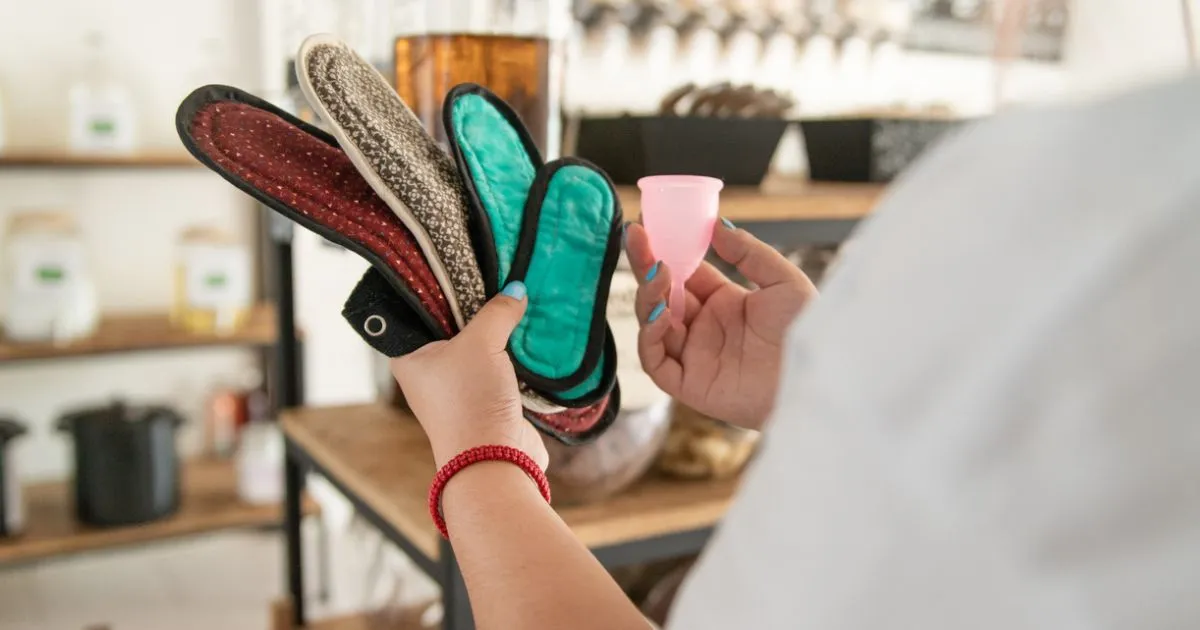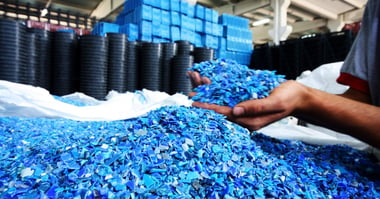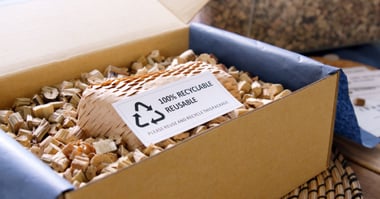
Maura Monaghan
Maura Monaghan has been a digital writer for five years now, covering everything from sustainable ecommerce to types of plastic. She's interested in ecommerce, sustainability, and the ways they can overlap. When she's not writing, she's probably out searching for the perfect cup of coffee.
Period products are an unavoidable necessity – but the traditional items we’re used to are often made of harmful materials that take an age to decompose and negatively impact our environment.
The good news is, there are tons of sustainable period products out there that you can use instead – and we’ll explain all of them on this page, along with some of the best brands for each type.
Check out our founders chat with Tampon Tribe owners Jennifer and Gaby. They share their journey of addressing their concern with plastic waste by creating a plastic-free, organic, and ICA-certified, sustainable menstrual product.
Read the full interview here.
What’s on this page?
01 | Summary: The best sustainable period products on the market
02 | The environmental impact of period products
03 | Are sustainable period products affordable?
04 | FAQs
Summary: The best sustainable period products on the market
|
Product |
What is it? |
Brands we recommend |
|
Menstrual cups |
Silicon-based, reusable cups that collect rather than absorb your flow |
OrganiCup, Grace & Green, Saalt |
|
Reusable pads |
Cotton- or bamboo-based pads you can put in the wash |
Tampon Tribe, Bloom & Nora |
|
Period underwear |
Washable, re-wearable absorbent underwear |
Thinx, Bambody, Tampon Tribe |
|
Sustainable tampons |
Single-use tampons made from biodegradable and organic materials |
|
|
Reusable tampon applicators |
Silicon-based reusable applicators |
Dame |
|
Non-applicator tampons |
Tampons as you know them, just without the applicator! |
Flo |
|
Flushable pads |
Pads that can be flushed rather than thrown in the bin |
Fluus, Planera |
1. Menstrual cups
Unlike disposable pads and tampons, menstrual cups are made of medical-grade silicone or rubber, which means you can reuse them for a long time – up to 10 years, by most estimates!
Over the span of ten years, one cup will only produce an estimated 0.4% of the plastic waste that single-use pads build up, and 6% of the waste generated by tampons.
Menstrual cups work by collecting your flow instead of absorbing it, and you can wear one for up to 12 hours – a whole day of worry-free, sustainable protection. Then you can just empty, rinse, and repeat – no more tossing out tons of products into the trash each month.
The price of a menstrual cup usually ranges from $20-$40, which isn’t too steep when you consider how long they last. That’s about as much as a 96-pack of tampons or pads.

2. Reusable pads and panty liners
Reusable pads and pantyliners work much the same as the disposable ones you’re used to, except that when you’re done with them you can simply pop them in the wash and use them again!
Reusable pads are made with sustainable, organic materials like cotton or bamboo, which are better for the environment because they biodegrade quickly and without leaking any toxic materials into the water or soil.
Some reusable products may also use polyester in one of their absorbent layers, which means they’re not completely without plastic, but the fact that you can use these pads many more times than their disposable counterparts means they’re still much better for the environment!
Although some reusable pads or panty liners can be priced pretty steep, the two brands we mention below both offer packs for under $30.
3. Period underwear
Period underwear almost sounds too good to be true: imagine regular undies that don’t require a pad or a tampon to keep you covered. They usually accomplish this with layers of moisture-wicking, absorbent fabric.
Price-wise, they range from around $15 to $40 per pair. This requires a bit more of an investment than regular underwear, but then again, is regular underwear five times less damaging to the environment than pads or tampons? That’s a huge win!
4. Sustainable tampons
Some of us haven’t hopped on the reusable train yet, and that’s totally okay – it’s all about what works best for you!
Sustainable tampons are like traditional tampons in that they can be disposed of after one use, but they’re typically made of organic cotton that’s grown without any funky pesticides or synthetic fertilizers.
That makes them better for the planet than traditional tampons because they’re biodegradable and won’t sit around in a landfill indefinitely. They’re also better for your body because you won’t be putting anything synthetic up there.
Sustainable tampons typically only cost a few extra bucks per pack than regular tampons, so it’s well worth the investment!
5. Reusable tampon applicators
While sustainable tampons themselves come with applicators that are made from biodegradable materials, those are still single-use products.
Reusable tampon applicators, on the other hand, are typically made from the same sort of medical-grade silicon used to make the menstrual cups we talked about earlier.
These usually cost between $10 and $25 – again, more expensive than their disposable counterparts, but likely to save you more in the long run. Dame was the first brand to create a reusable applicator, and their eco-friendly product lasts for over 3,000 uses.
6. Non-applicator tampons
At this point, we’ve covered reusable applicators and ones made from sustainable materials, but of course the most eco-friendly applicator option of all is to simply not use one.
This isn’t for everyone – and no shame if you simply don’t love the idea – but there are plenty of non-applicator tampons on the market if you want to give it a go.
Another upside is that this option is usually cheaper than regular tampons because, well, you’re only really buying half the product.
7. Flushable pads
We know, we know – this idea goes against just about every common sense rule (and public bathroom signage) there is, but flushable pads are now a thing, and they’re more eco-friendly than their other single-use contemporaries.
They’re made of plant fibers and biodegradable polymers, and are designed to break down in water, saving much of the plastic waste that ends up in landfills thanks to traditional pads. Price-wise, they’re not much different from regular pads, either.
When you flush one of these pads down the toilet, the motion of the water breaks apart the fibers, and the pad is then treated along with toilet paper and sewage as it is turned into clean water.

The environmental impact of period products
On average, a single person who menstruates (and has access to period products) will use between 5,000 and 15,000 pads or tampons during their decades of menstruation. That translates to about 10,000 kg of waste and 212 kg of CO2 equivalent. Or in other terms, the equivalent weight of two fully grown killer whales!
It also means that if Joan of Arc had used plastic-based period products, they’d still be decomposing in a landfill today.
Because traditional period products are non-biodegradable, they often go on to pollute soil and water while sitting in landfills, leaking microplastics and other hazardous materials.
Pads and tampons as we know them take about 500-800 years to decompose – so switching to more sustainable period products is a surefire way to reduce waste.
Want to find out how to reduce your plastic consumption? Check out our guide on 19 Ways to Reduce Plastic Waste at Home.
Are sustainable period products affordable?
As you’ll realize if you’ve read this far, most sustainable period products cost more upfront than disposable tampons or pads – but it’s often not as steep a price as it first appears to be, because you won’t have to keep replenishing your stock every month.
One UK study estimates that each period with single-use products costs about £10 on average, or £130 per year. Compare that with a menstrual cup, which costs around £20 and can last for up to 10 years – it ends up paying for itself rather quickly. In fact, you could save about £1,300 over 10 years!
Still, remember that it’s not your fault many of the easiest products to buy aren’t made from sustainable materials. If more eco-friendly options are out of your price range, don’t feel guilty about buying what you need! But if you do have the cash to spare, making an investment in yourself that also helps the planet is never a bad way to spend it.
Summary
There’s no shortage of sustainable period products out there to try, from reusable pads to non-applicator tampons. And for each product type, there are some great brands paving the way towards more eco-friendly menstruation.
FAQs
Is the menstrual cup safe?
Menstrual cups differ from tampons in that they collect blood rather than absorb it. However, they’re just as safe to use – provided you use them correctly. Just like tampons, it can be dangerous to leave a menstrual cup in for longer than the specified amount of time.
It’s also important to follow the brand’s recommendations on how to clean your cup, otherwise it could lead to infections.
Are reusable period pants hygienic?
Yes, period pants are hygienic as long as you wash them properly. In most cases, you’ll want to rinse the pants under cold water until they’re clear, and then wash them with stain remover in a cool wash. It requires more effort than single-use pads, but high reward!
How do you sanitize reusable pads?
If you really want to make sure your reusable pads are as good as new after each use, you can leave them in cold water overnight before placing them in the washing machine.


.webp?width=380&name=Plastic-on-the-beach%20(1).webp)
.webp?width=380&name=ESG-presentation%20(1).webp)
.webp?width=380&name=Sustainable%20christmas%20(1).webp)


.webp?width=380&name=Buying-online%20(1).webp)
.webp?width=380&name=Sales%20(1).webp)

.webp?width=380&name=Sorting-trash%20(1).webp)
.webp?width=380&name=Ecommerce-business-owner%20(1).webp)
